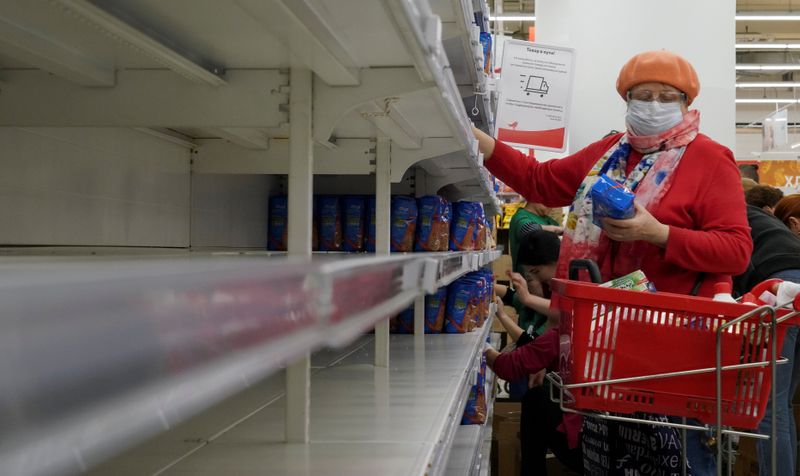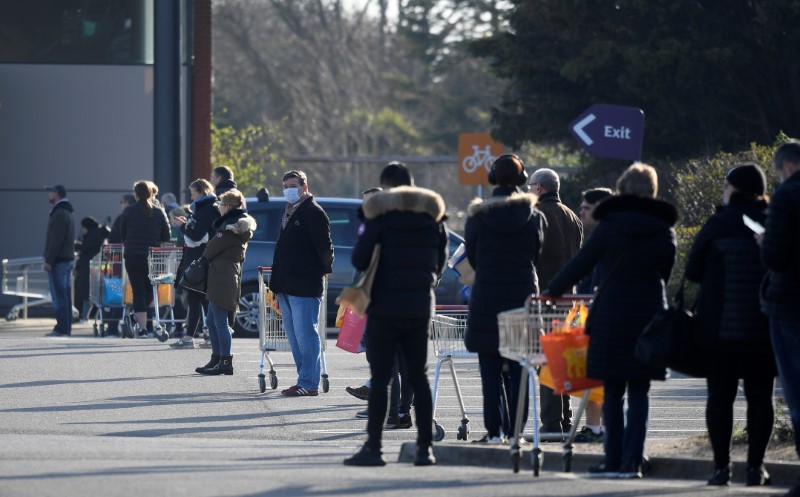By Naveen Thukral and Maha El Dahan
SINGAPORE/DUBAI (Reuters) - Global food security concerns are mounting as some governments contemplate restricting the flow of staple foods with around a fifth of the world's population under lockdown to fight the widening coronavirus pandemic.
Panic buying of household items and store cupboard staples such as rice and flour has occurred in nearly every country hit by the virus, which has infected over 470,000 people across 200 countries. Empty shelves in supermarkets have been common.
The erratic nature of consumer buying is stoking concern that some governments are moving to stem the flow of food staples to ensure their own populations have enough while supply chains are disrupted by the pandemic.
"If major exporters start keeping grains at home, it will have the buyers really worried," said Phin Ziebell, agribusiness economist at National Australia Bank. "It is panicking and not rational, as fundamentally the world is well supplied with food."
Vietnam, the third largest rice exporter, has already restricted sales amid concerns over domestic availability.
"If Vietnam maintains the export ban we will suddenly have about 10-15% less available supply in the world market in the near term," one European rice trader said. "Africa especially could face disruption from this."
India, the top global rice exporter, has just entered a three-week lockdown that has brought several logistics channels to a halt.
Elsewhere, Russia's vegetable oil union has called for a restriction in sunflower seed exports, and palm oil output has slowed in the number two producer Malaysia.
WHEAT MARKET ON EDGE
Russia, Ukraine and Kazakhstan have so far been able to maintain wheat exports after decent 2019 harvests, but Russia-focused grain traders are nervous.
"I am absolutely sure there will not be a harsh scenario - like Russia leaving the market. But I think there is going to be some soft scenario," a trader said on Thursday, referring to wheat and other types of grain.
At the same time, some importers are trying to boost strategic supplies while others are finding glitches in supply chains.
In Egypt, the world’s largest wheat buyer, there have been delays in offloading Black Sea grain supplies from ships, with paperwork slowed by office closures due to the virus.
"There are at least four cargoes, corn and wheat, for the private market that I know have been delayed at the ports," Hesham Soliman, a private grain trader, said.
The cargos are all for the private sector and Egypt’s government has said it is well stocked with strategic supplies for four months ahead.
Iraq has said it needs to import 1 million tonnes of wheat and 250,000 tonnes of rice after a "crisis committee" advised building up strategic food stocks, while Qatar is also signing agreements to increase its reserves.
However, most wheat buyers in Asia, led by the world's second largest importer Indonesia, are covered for supplies until June, traders said.
"As of now we have not seen any wheat importer rushing to cover supplies more than the usual needs," said one trader in Singapore at an international trading company which sells Black Sea and U.S. wheat in Asia.
(GRAPHIC: Rice and wheat exports prices - https://fingfx.thomsonreuters.com/gfx/ce/7/9225/9206/RiceWheatPrices.png)
NO SHORTAGE
Combined global production of rice and wheat - the most widely-traded food crops - is projected to be a record 1.26 billion tonnes this year, according to the United States Department of Agriculture data.
That output tonnage should easily surpass total combined consumption of those crops, and lead to a build in year-end inventories to a record 469.4 million tonnes, USDA data shows.
However, those projections assume normal crop flows.
Prices for rice are already rising due to expectations of a further squeeze on exports.
"It is a logistics issue. Vietnam has stopped exports, India is in a lockdown and Thailand could declare similar measures," said a senior Singapore-based trader at one of world's top rice traders.
Benchmark rice prices in Thailand
The market topped $1,000 a tonne during the food crisis of 2008, when export restrictions and panic buying buoyed prices.
"We are unlikely to see a repeat of 2008," the Singapore rice trader said. "One thing is that the world has enough supplies, especially in India where inventories are very large."
(GRAPHIC: No shortage: Combined rice & wheat output, exports and stocks expected to be at or near all-time highs this year - https://fingfx.thomsonreuters.com/gfx/ce/7/9226/9207/RiceWheatOutputEtc.png)
Global rice stocks are estimated to surpass 180 million tonnes for the first time this year, up 28% since the 2015-16 season.
But those inventories are not distributed evenly, with more than 153 million tonnes in China and India alone.
That means big rice buyers such as the Philippines, the top importer, and others in Asia and Africa could be vulnerable if crop movements are curtailed for long.
"Our rice inventory is good for 65 days. We have enough rice for the next two months," said the Philippines Agriculture Secretary William Dar, adding that with additional supply coming from the dry season harvest, there would be enough for the next four months.

(GRAPHIC: Months of rice stocks in top importers - https://fingfx.thomsonreuters.com/gfx/ce/7/9227/9208/RiceintopImporters.png)
